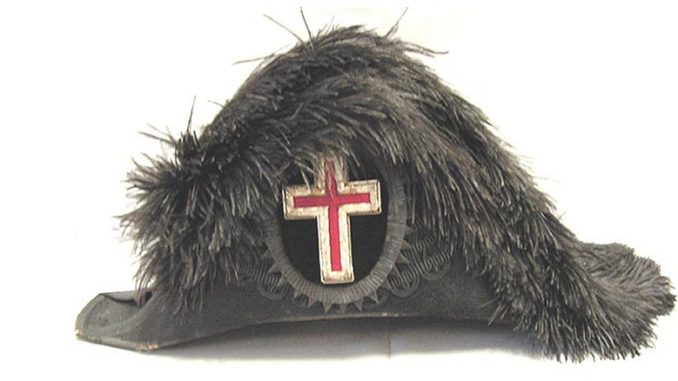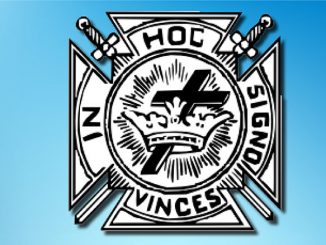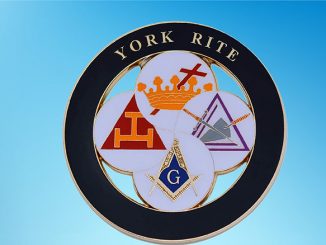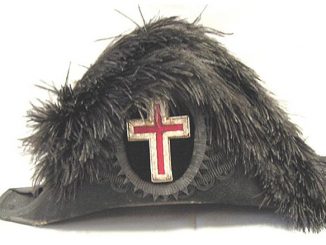
A Short History Of The Early Days Of Masonic Templarism by Stanley C. Warner
LARGE numbers of our members and, in fact, many of our Templar speakers, are still imbued with the fiction that modern Masonic Templarism has a direct connection with and is the lineal descendant of the Knights Templar Order, instituted in 1113 by Hugh DePayne to protect pilgrims on their journey to the Holy Land, and one often hears both publicly expressed and inferentially suggested that our present Grand Master holds his office in direct accession to the martyred Jacques de Molai, whom an avaricious king of France, with the concurrence of an infamous Pope of Rome, burned at the stake in Paris, March 18, 1313: this despite the fact that this pleasing fiction has been discarded by numbers of our prominent Masonic writers and historians during the last quarter of a century, Sir Knight Colman in his Centennial address to the Grand Encampment in 1916 upon the subject of the early history of that body, said:
“There is no probability, hardly even any possibility, that our modern Order of Christian Masonic Knighthood is directly connected with the ancient Order of Christian Knights whose name and date we proudly bear and whose valiant character and Christian virtues we emulate.”
Dr. Rugg, Past Grand Master of the Grand Encampment, in his Centennial address to the Grand Commandery of Massachusetts and Rhode Island, said:
“Tradition and common belief have their value, but they must not be allowed to offset historic evidence. It is the part of unwisdom to cling to a theory that has been generally discarded by those who have made the most extensive and careful examination of the grounds on which it rests. In this case the most reliable authorities concur in judgment that Masonic Templary, as recognized in the eighteenth and nineteenth centuries, is not historically connected with or lineally descended from the chivalric orders of the Crusades.”
Sir Hopkins, Past Grand Master of the Grand Encampment, at the Conclave held in Louisville in 1901, said:
I readily admit that we can not show an indisputable title to this inheritance, but the claim is precious although the title may not be secure. I would fain believe that the founders of the Order did not leave the organization which they founded and cemented with their blood to become the plaything of chance or to rest upon the uncertain tenure of the will or whim of a rapacious king and a weak pope. I am disposed to admit that it is only a sentiment, but it is one to which some of us cling tenaciously and which we only surrender when we recognize that tradition must yield to history.”
Sir Knight Parvin, Past Grand Recorder of Iowa and for many years closely connected with the Grand Encampment, has said: “The popular theory under which so many writers view the origin and history of Templar Masonry would trace it back by some mysterious line of connection to the Order of Malta which was dissolved in 1798, or back to the Order of the Temple, which ceased to exist in 1313, and the latter theory, even at this day, has many advocates. A better and truer theory, is to credit the whole system of Masonic Templarly to the inventive genius of the ritual makers of the eighteenth century.”
Lieut. Col. W.J.B. MacLeod Moore, Supreme Grand Master, ad vitam, of the Sovereign Great Priory of Canada, frequently declared in his annual allocutions that Freemasonry was not the successor of the military Templars.
The published addresses of the distinguished Templars to which references have been made are not of easy access to the membership of our Order, and in presenting a short account of our early history at this time, we have in mind that the information will be thereby more generally available to such Templars as are interested therein. We make no claim of any personal research, but simply present to you the facts as collected from the works of Eminent Sir Knights who have made a life study thereof.
Four long centuries elapsed after the death of Jacques de Molai and the destruction of the ancient Order before history or even Masonic tradition suggests the existence of Masonic Templarism. During these four centuries civil history is silent as to the Templars, and little is known or related of the Masonic Order. Masons met without charter or other authority, initiated candidates, often without even an organized lodge or without record of the same, this by a claim of inherent right, and with no intent or desire to make their proceedings public. It was only in 1717 that the Masonic Fraternity assumed an organized existence, and it was shortly after this date that we find the first suggestion of the Modern Templar Degree. The long cherished alleged connection of the two orders through Scottish sources rests largely upon the fact that among the adherents of the Stuart Pretender who fled to France after his defeat in the early part of the eighteenth century, was one Chevalier Ramsay, a Mason, a gentleman of much culture, and a tutor of the Second Pretender, Charles Edward. This distinguished exile, while in France, is said to have developed a Masonic system with a sixth degree, designated the Knight of the Temple, and during one of his visits to Scotland, to have created Knights Templar there. With the Pretender’s approval he attempted to use his Masonic connection to aid the exiled Stuarts, and in grafting upon Masonry a Military Order, he may have had in mind the assistance which it might be to his benefactor. Masonic authorities differ as to the truth of these statements, but in any event the Templar Degree was occasionally conferred in Great Britain during the middle of the eighteenth century, and encampments of the Order were during that period formed at London, York, Bristol, and Salisbury, more or less intimately connected with Craft Masonry.
Moore says that “Masonic Templarism was first introduced into the British Empire in the Masonic lodges known as the Ancients under the Duke of Athol, who was also Grand Master of Scotland, in the eighteenth century,” and that about 1780 the Templar Degree was merged into the Masonic system, following the Royal Arch in the sequence of additional degrees.
- Redfern Kelly, G.C.T., in a series of articles in the Toronto Freemason, published since this speech was first written, says that the records of the York Grand Lodges, designated also the Grand Lodge of all England, of date June, 1780, announced that lodge as asserting authority over five degrees or orders of Masonry, the Entered Apprentice, Fellow Craft, Master Mason, Royal Arch and Knight Templar, and also show the conferring of the Templar Degree at York, England, on November 29, 1779. He further asserts that this Grand Lodge was the only one which officially recognized the Order of the Temple as being Masonic, in either Great Britain or Ireland during the eighteenth century.
The history of the Order of the Temple, by Sir Patrick Colquhoun of London, England, published in 1878, is authority for the statement that in 1769 the Mother Kilwinning Lodge of Scotland issued a charter to Kilwinning Masonic Lodge of Dublin, which authorized the conferring of the degree of Knight Templar therein, but it would appear that the Order was found in Dublin prior to that date in the possession of military organizations composed of the soldiers of Scotland and Ireland. It is probably by this same military source that the Order was introduced into this country in Boston about the same period. Hughan, the great English Masonic authority, makes the positive statement that the first authentic record of the conferring of the Order is found in the minutes of St. Andrews Royal Arch Lodge in Boston under date August 28, 1769, where we read that “the petition of Bro. William Davis coming before the lodge begging to have and receive the parts belonging to a Royal Arch Mason, which being read, was received and he unanimously voted in, and was accordingly made by receiving the four steps, that of Excellent, Super-Excellent, Royal Arch, and Knight Templar.”
Like the history of Masonry prior to 1717, the early history of Masonic Templarism consists of the record of the meetings of Knights of the Order in various places for the purpose of conferring the same, without any constituted authority, by inherent right only, acting sometimes with and sometimes without the sanction of regular Masonic lodges.
The records of this same St Andrews Royal Arch Chapter show that in December, 1769, “the petition of Bro. Paul Revere coming before the lodge begging to become an Arch Mason, it was received and he was unanimously accepted and accordingly made.” He subsequently became in the same body a Knight Templar. In 1770 it was voted “that the M. M. Joseph Warren, Esq., should be made a Royal Arch Mason this evening, and he was accordingly made, gratis.” The minutes of this body show the conferring of the order or degree of Knight Templar on about 50 candidates between the years 1769 and 1794.
In the last decade of the eighteenth century encampments were formed by prominent Craftsmen in Massachusetts and Rhode Island, at Boston, Providence, Newburyport, and Portland (now in Maine), at Philadelphia, Pennsylvania; at Wilmington, Delaware; at Albany and New York City; at Baltimore, Maryland; and at Charleston, South Carolina, in all of which encampments the Order of the Temple was conferred.
The next step was the formation of Grand Encampments, as they were then called, in the various states. The first was organized in Philadelphia, May 12, 1797, with four constituent bodies. It had but a brief existence, was revived in 1814, again became extinct in 1824, and remained so during the Anti-Masonic Excitement. It was again revived in 1852 under the authority of the Grand Lodge of Pennsylvania, to which it acknowledged allegiance until 1857, when, with the consent of the Grand Lodge of Pennsylvania, it became part of the Grand Encampment of the United States.
The most important event in this era of Templar history was the organization in 1805 at the city of Providence of the Grand Encampment of Massachusetts and Rhode Island. This is especially true, because the Templars responsible for its organisation were almost identically those who subsequently in 1816 participated in the organization of our present governing body, and as any history of our Order is incomplete which does not particularly deal with the lives of at least three of these pioneers of American Masonic Templarism, we shall for a few moments digress from the actual subject under consideration.
Thomas Smith Webb, founder of St. John’s Encampment in Providence in 1802, presiding officer from 1805 to 1817 of what is now called the Grand Commandery of Massachusetts and Rhode Island, and Deputy Grand Master from 1816 until his death in 1819, of the General Grand Encampment of the United States, was born in Boston in 1771, was made a Mason in New Hampshire in 1792, a Royal Arch Mason in Philadelphia in 1796, and a Knight Templar sometime previous to 1802, either in Temple Encampment at Albany, in a Philadelphia Encampment, in the Boston Encampment, or in the Old Encampment of New York City, all four of which still claim the honour. He was the author of several successive editions of “The Free Mason’s Monitor,” was an organizer of great ability, had an attractive personality, a win-some manner, with indefatigable energy, and a great versatility of language, both written and oral, all of which joined in making for him the high reputation which he has since held as a Masonic ritualist and organizer. He has been said to have invented the American system of Templary, and there is no doubt that he, along with Fowle, is responsible for the present impressive ceremonies, not only of the Templar Order but, in a large measure, of Craft Masonry and the Royal Arch system. He died suddenly July 6, 1819, while on a visit to Cleveland, Ohio, and was buried there just shortly prior to the Second Triennial Session of our Grand Encampment. His remains were subsequently removed to the North Burial Ground at Providence, Rode Island, where a monument of white marble has been erected to his memory.
Henry Fowle, first Sovereign Master of Boston Encampment of Red Cross Knights and Grand Master of that Encampment when it was reorganized as a Templar body in 1806, which office he held until 1824, Grand Generalissimo of the Grand Commandery of Massachusetts and Rhode Island from its organization in 1805 until 1817, then its Deputy Grand Master and subsequently its Grand Master from 1820 to 1825; was named Grand Generalissimo of the General Grand Encampment at its organization in 1816, and was elected Deputy Grand Master at the Triennial Conclave in 1819. Sir Knight Fowle was a member of St. Andrew’s Chapter of Boston, where he received the Knight Templar degree on the 28th of January, 1795. He was a great friend of Webb, and a ritualist of a very high order. He was a well known lecturer and his powers of organization made him, when working in conjunction with Webb, a potent factor in all branches of Masonic, work. To the efforts of these two men is due the organization of what is known at present as the Grand Commandery of Massachusetts and Rhode Island, and also that of our present governing body, to which reference will be made later.
DeWitt Clinton was born at Little Britain, New York, in 1769, and died in February, 1828. He was the father of the Great Canal System of the Empire State, served as its Governor, having resigned a seat in the United States Senate for the purpose, was in 1812 a candidate against James Madison for President of the United States, was Grand Master of Masons of New York from 1806 to 1819, was selected first Grand Master of the General Grand Encampment of the United States in 1816, and served as such until his death on the 11th of February, 1828. He devoted a busy and useful life to the service of his community and to an Order which he considered as wielding a great influence for good in the government, both of his state and country. He was at the head of the Order during the early days of the unfortunate Morgan excitement, and did much by his influence to alleviate the disastrous conditions which resulted therefrom. He was a lawyer, a statesman, and a patriot, and with Webb and Fowle formed a combination to which is largely due the present status of Masonic Templarism in the United States.
The Grand Encampment of New York was organized in 1814; and was in a great measure an outgrowth from the “Sovereign Grand Consistory” organized by the well-known Masonic charlatan, Joseph Cerneau.
There were in existence in 1816 three sovereign grand bodies of the Order – Pennsylvania, Massachusetts and Rhode Island, and New York, in addition to which there were isolated encampments working in Connecticut, Maryland and South Carolina. The great organizers Webb and Fowle, having about twenty years previously launched the General Grand Chapter of the United States, endowed by their state Grand Encampment with more or less authority, along with some Templars from New York, held a convention in Philadelphia on June 11, 1816, where they met with delegates from Pennsylvania and endeavoured to organize a United States Grand Encampment. Opposition developed thereto on the part of the delegates from Pennsylvania, who refused to concur in the adoption of a proposed constitution, preferring rather their own ritual, their own customs, and their own powers of government, being influenced largely by their connection with the Mother Grand Lodge of Pennsylvania, to which they were then and until 1857 subject. Unsuccessful in their efforts, but still undaunted, Webb and Fowle stopped over in New York City on their way home and there, within ten days, organized what is today the Grand Encampment Knights Templar of the United States of America; adopted a constitution, carefully prepared by Webb, which remained essentially unchanged until 1856; prepared a roster of officers substantially the same as at present prevailing; and named candidates for those offices from their two state jurisdictions, Webb and Fowle wisely subordinating themselves to Governor Clinton, whose civil position, along with his Masonic record and his powerful influence rendered him eminently fit to act as Grand Master of the organization. It remained only for the Knights of Massachusetts and Rhode Island, and New York to ratify this action and make such changes in the constitution of their different bodies as were thereby necessary.
During the thirty-six years following the formation of the Grand Encampment but six additional Grand Commanderies were added to its roster, a slow growth due solely to the persecution of the members of the Order for a score of years following the Morgan Excitement. During the fifties, ten Grand Commanderies were added to the list, when our great Civil War, along with its disturbance of the general affairs of the nation, for many years delayed the spread of the Order over the United States. Since that war its growth has been healthy and normal, and today we have forty-seven Grand Commanderies in the United States, with a total membership of over 368,000.
Outside of the United States, the activities of modern Masonic Templarism are confined to the British nation, with whose Great Priories of England and Wales, Ireland, Scotland, and Canada, we are, by the Concordat of 1910, in fraternal relationship.
About Us
We hope you enjoyed this article on Masonic Templarism.
TemplarHistory.com was started in the fall of 1997 by Stephen Dafoe, a Canadian author who has written several books on the Templars and related subjects.
Read more like this article on Masonic Templarism from our Modern Templars Archives – Templar History
Masonic Templarism by Stanley C. Warner



